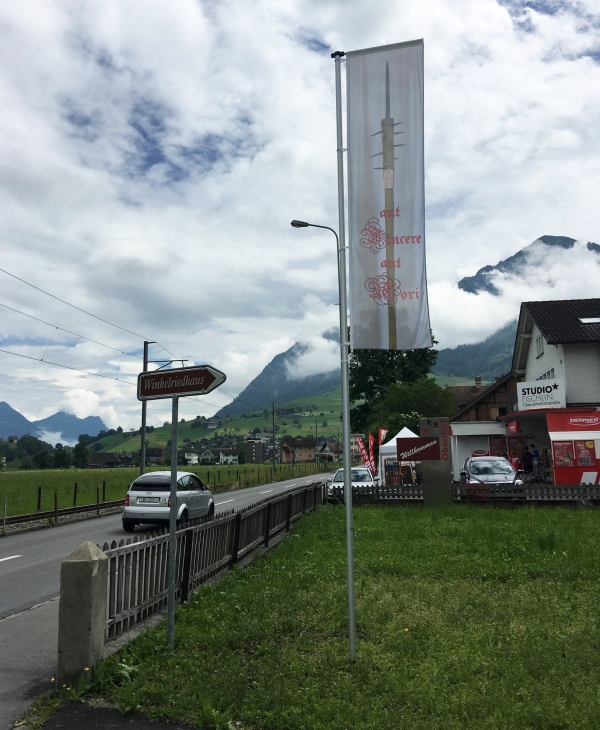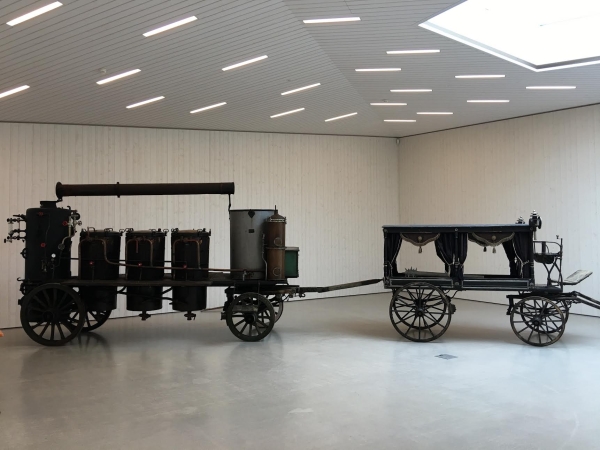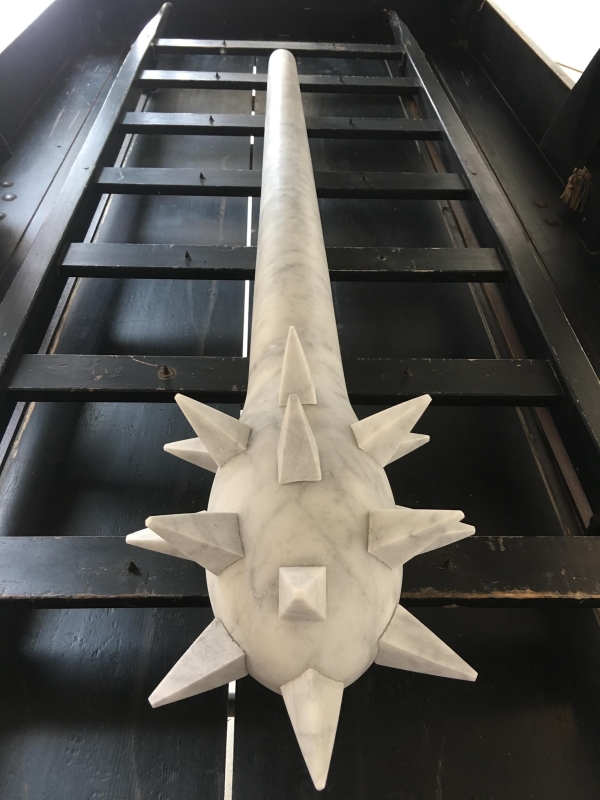
Exhibition poster featuring pitchforks.
Exhibition brochure.
Exhibition brochure with plan of Pavilion.
Installation view, Pavilion. (From left to right) Mobile brewery, funerary cart, found object, “Zwischen den Akten.”
Installation view, Pavilion. (From left to right) Mobile brewery, funerary cart.
Installation view, Pavilion. (From left to right) Arnold Odermatt Stans, Cowboy Trübseealp Nidwalden, State flag of Nidwalden.
Installation view, Pavilion. Spiked mace on funerary cart.
Arnold von Winkelried memorial, Stans.
Aut vincere, aut mori
12 June – 16 October 2016
Nidwaldner Museum, Winkelriedhaus, Stans, Switzerland
Pavilion installation:
- “Aut Vincere, aut mori,” 2016; polyester flag, 320 x 80 cm.
- Pitchfork, no date (first half of the 20th century). Maple and iron; 151 x 35 x 30 cm. Collection of the Nidwaldner Museum.
- Schnapps distillery, 1930. Wooden wagon with distillery, cast-iron oven, metal tank, copper distiller pot; 547 x 538 x 176 cm. Collection of the Nidwaldner Museum, permanent loan, Swiss Alcohol Board, Bern.
- Hearse, no date (up to the beginning of the 20th century). Wooden wagon, curtains, cords; 195 x 340 x 153. Collection of the Nidwaldner Museum, permanent loan, Wolfenschiessen Parish.
- Spiked mace, 2016. Carrera marble (1/3); 135 x 25 x 25 cm.
- Found object (piñata), 2016. Various materials.
- “Zwischen den Akten” (Between the Acts). Screen-print poster.
- State flag of Nidwalden, 1802. Painted Silk, frame; 236 x 207 x 9 cm. Inscription: “Für Gott und Vaterland. Siegen oder Sterben” (For God and fatherland. Victory or death); Nidwaldner keys, and Lorbeer-Kranz. Collection of the Nidwaldner Museum.
- Cowboy Trübseealp Nidwalden (1966), 2016. Photograph from the Müller family album. Digital print on chiffon, framed; 118 x 116.5 x 8 cm.
- Arnold Odermatt Stans, 1978. C-print mounted on museum cardboard; 50 x 50 cm. Edition 15/15.
Winkelreid Haus exhibition:
- Archival documents related to the museum’s collection
- Interventions by Müller
Situating himself conceptually in place and time, Christian Philipp Müller’s installations are always distinguished by in-depth research. His works convey the specific situation of the exhibitions they comprise, establishing a tension between preservation and disappearance. His works provide a resonant space for observing the conditions he has encountered. Into these "factografic” exhibition narratives, he superimposes demonstrable facts about the past, present, and future.
For this exhibition, the Nidwaldner Museum invited Müller to engage its diverse collection inventory. This included both works of art and artifacts from the cultural history of Central Switzerland and the Canton of Nidwalden: religious objects and everyday objects were just as important as works of contemporary art from the region. Indeed, it was this general orientation of the museum and its collection that interested Müller. Working with an inexhaustible list of about 17,000 entries in the museum’s database, his first choices were among some of the largest objects in the collection: a mobile schnapps distillery, which was given as a permanent loan to the museum by the Swiss government in 1983; and a hearse, a permanent loan from the Wolfenschiessen Parish. Additionally, Müller chose a large flag of Nidwalden’s coat of arms dating back to 1802, which depicts a silver key inside a laurel wreath at the center of the red silk fabric. The flag also bears the inscription “Für Gott und Vaterland. Siegen oder Sterben” (For God and Country. Victory or Death), which served as the impetus for the exhibition’s title: “aut vincere aut mori” (Latin for “either to conquer or die”). Müller’s intervention plays with both venues of the Winkelriedhaus: the historic building as well as the pavilion, a new building in the yard.
In order to capture the interplay of different levels of perception, Müller draws on a variety of artistic means of expression. He employs a spectrum of media from photography and sculpture, to video and performance. Müller's artistic practice has been described as a critical one because he does not distinguish between artistic and non-artistic activities, nor do these activities have clear roles, boundaries, or hierarchies. Just as Müller repeatedly juxtaposes different locations and points of view, he tests himself through various roles: performer, researcher, art educator, tour guide, exhibition manager, and tourist. He investigates the location and the conditions of his exhibitions. Thus, in “aut vincere aut mori,” his selection of objects from the Nidwaldner Museum’s collection was a starting point for associative interrelationships, in which local history and art history were interwoven with his biography.
//
Christian Philipp Müller setzt sich in seiner Arbeit konzeptionell mit Ort und Zeit auseinander. Seine Installationen zeichnen sich stets durch eine eingehende Recherche aus. Das Spezifische der Ausstellungssituation überträgt er auf seine Arbeit, die ein Spannungsfeld zwischen Vergehen und Bewahren erzeugt. Mit seinen Werken und Installationen öffnet er so einen Resonanzraum der vorgefundenen Bedingungen. Es sind «faktografische» Ausstellungserzählungen, in denen er nachweisbare Fakten aus Vergangenheit, Gegenwart und Zukunft übereinanderschichtet.
Auf Einladung des Nidwaldner Museums beschäftigt sich Christian Philipp Müller mit dessen vielfältigen Sammlungsbestand. Dieser umfasst sowohl Werke der Kunst- als auch der Kulturgeschichte der Zentralschweiz und Nidwaldens: Kirchliche Objekte oder Alltagsgegenstände zählen ebenso dazu wie Arbeiten des aktuellen Kunstschaffens aus der Region. Dabei ist es gerade die breite Ausrichtung eines Museums oder dessen Sammlung, die Müller interessiert. Im schier unerschöpflichen Konvolut von rund 17000 Einträgen in der Museumsdatenbank fiel seine Wahl zunächst auf die größten Objekte: Eine mobile Schnapsbrennerei, die dem Museum 1983 von der Eidgenössischen als Dauerleihgabe überlassen wurde, sowie ein Leichenwagen — eine Dauerleihgabe der Kirchgemeinde Wolf einschießen. Weiter entschied sich Christian Philipp Müller für eine große Landesfahne von Nidwalden aus dem Jahr 1802. Ein silberner Schlüssel im Lorbeerkranz bildet das Zentrum dieses roten Seidentuchs. Die Fahne trägt überdies die Inschrift «Für Gott und Vaterland. Siegen oder Sterben» und war insofern Impulsgeber für die Wahl des Ausstellungstitels «aut vincere aut mori», zu Deutsch «Siegen oder Sterben». Mit seiner Intervention bespielt Christian Philipp Müller beide Ausstellungsorte beim Winkelriedhaus — das historische Gebäude sowie den Pavillon als Neubau im Hof.
Um das Zusammenspiel verschiedener Wahrnehmungsebenen zu erfassen, zieht Christian Philipp Müller eine Vielzahl künstlerischer Ausdrucksmittel heran. So umfasst das eingesetzte mediale Spektrum Fotografie, Skulptur, bis hin zu Video und Performance. Müllers künstlerische Arbeit ist auch als kritische Praxis zu beschreiben. Weil sie nicht zwischen künstlerischen und nicht-künstlerischen Tätigkeiten unterscheidet. Ebenso wenig kennt sie klare Rollen, Grenzen oder Arbeitshierarchien. So wie Christian Philipp Müller immer wieder verschiedene Standorte und Blickwinkel überblendet, so erprobt er sich selber in verschiedenen Rollen: Mal Performer, mal Forscher, Kunstvermittler, Fremdenführer, Ausstellungsleiter oder Tourist. Er fragt nach dem Ort und den Bedingungen der Ausstellung. Dementsprechend wird die von ihm für die Ausstellung «aut vincere aut mori» getroffene Auswahl an Objekten aus der Sammlung des Nidwaldner Museums auch zur Ausgangslage für ein assoziatives Beziehungsgeflecht, in dem sich Lokalhistorie und Kunstgeschichte mit seiner Biographie verweben.
Text by Patrizia Keller, Nidwaldner Museum
Translation by Cara Jordan
Edit by Gillian Sneed









